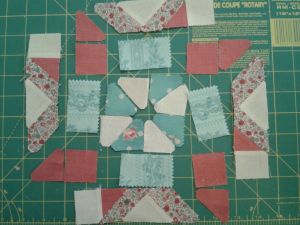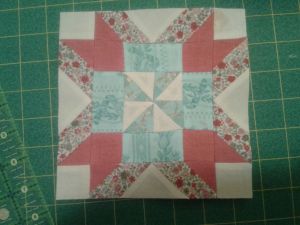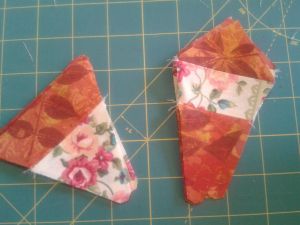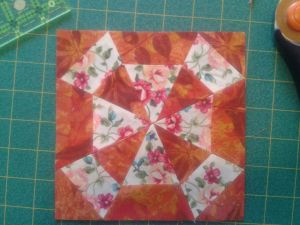This block really intrigued me. I know that every single block can take on a completely different look just by changing the fabric selections, but this one is such a dramatic change it caught me off guard. So, being a curious sort, I went to the internet to see if I could find any information of this block. The answer was a resounding NO. Different sites had patterns for it, but no other info. Pooh. If you know anything about it, please let me know. For instance, why is a star block named Silver Lane? Makes me wonder if it got it’s name due to the original fabrics used to make it for the first time.
For this one, I’m going to refer to everything by it’s template number. There are 3 colors of template #13, and I will refer to them as A, B, or C. There are two colors for #19, and they’ll be A or B as well.
 A lot of the time, I’ll start in the center of a block and work my way out, but this one had so many pieces I decided to work from the outside in.
A lot of the time, I’ll start in the center of a block and work my way out, but this one had so many pieces I decided to work from the outside in.
To get started, I chose the #20 triangles from the outside edge and sewed a #100 to one side and a #100R to the other. I pressed the seams open gently, knowing this could distort easily. Then I sewed a #13C to either side, matching the long edge of the triangle to the angled edge of the strip. For the Right and Left strips, I sewed a #19A square to each end. More gentle pressing and I laid them back in place. I moved in one step on the Right and Left sides, and sewed a #19B to either end of a number 25 rectangle.
 For the center pinwheel, sew together one #13A and #13B triangle; repeat 3 more times. Press the seams. Sew them together in pairs, then sew the pairs together. Take time to make sure the seams match up in the center. Take the remaining #25 rectangles and sew them on opposite sides of the pinwheel.
For the center pinwheel, sew together one #13A and #13B triangle; repeat 3 more times. Press the seams. Sew them together in pairs, then sew the pairs together. Take time to make sure the seams match up in the center. Take the remaining #25 rectangles and sew them on opposite sides of the pinwheel.
Starting in the center, sew the two inner strips to opposite sides of the pinwheel unit, using pins to help match up the seams. After a careful pressing, sew the top and bottom outer strips to the pinwheel unit. I finger pressed to find the center and lined it up with the points of the #20 triangle in the outer strip. Press.
 The last step is to sew the Right and Left outer strips to the Right and Left sides of the bloc, respectively. Pins will be your friends with this step because it’s imperative to match up all the seams.
The last step is to sew the Right and Left outer strips to the Right and Left sides of the bloc, respectively. Pins will be your friends with this step because it’s imperative to match up all the seams.
The end result is a stunning block that looks much more complicated than I thought it would be.
 This block is made of wedge pieces that, honestly, remind me of candy corn, especially if you use an orange and a light color. Which I did.
This block is made of wedge pieces that, honestly, remind me of candy corn, especially if you use an orange and a light color. Which I did. Using pins to match up the seams, lay the pieces right sides together and sew together in pairs.
Using pins to match up the seams, lay the pieces right sides together and sew together in pairs. Lastly, sew the two halves together to make the full block. You need to be really careful to match up the seams to make sure your center points meet neatly. Mine don’t, but I decided they were close enough to suit me. Looking at the picture, though, I’m not so sure.
Lastly, sew the two halves together to make the full block. You need to be really careful to match up the seams to make sure your center points meet neatly. Mine don’t, but I decided they were close enough to suit me. Looking at the picture, though, I’m not so sure.









